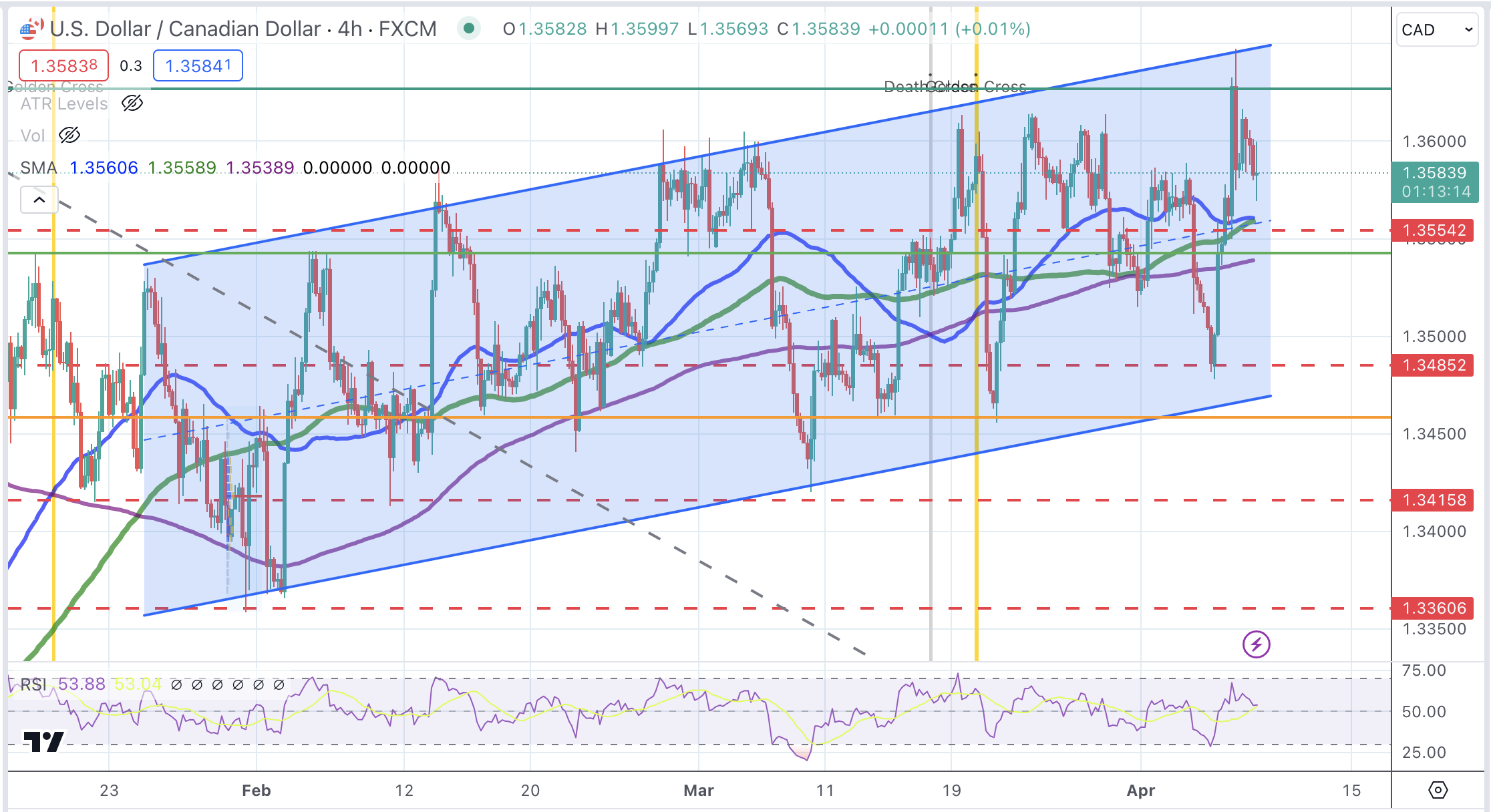- The Canadian dollar rebounds while the USD loses ground in a session of risk appetite.
- Investors are on the sidelines awaiting US CPI and the BoC's interest rate decision on Wednesday.
- USD/CAD maintains its positive trend intact and CAD recovery attempts are limited.
The Canadian Dollar (CAD) trades moderately higher on Monday, extending the rebound from year-to-date lows after Friday's upbeat Ivey PMI offset the negative impact of upbeat US Non-Farm Payrolls. A modest risk appetite in a very quiet weekly opening is allowing some pullback in the US dollar, pending this week's key macroeconomic data.
The US economy created many more jobs than expected in March, while wage growth moderated, although it remains at levels incompatible with the Federal Reserve's (Fed) goal of 2% core inflation for stability Of the prices. Last week, Fed officials hinted at hawkishness in light of the latest data, which is expected to limit the US dollar's downward moves.
Investors, however, will stay on the sidelines on Monday, awaiting Wednesday's US CPI numbers to see if the recent spike in inflation is an exception or a structural trend. Also on Wednesday, the Bank of Canada (B0C) will release its monetary policy decision. There is a small risk of an unexpected rate cut, causing the CAD to fall.
Daily Market Moves Summary: USD/CAD Rises in Quiet Market
- The Canadian dollar barely moves on Monday, although it continues to maintain some losses after hitting four-month lows on Friday.
- The most notable data of the week is the US CPI which will be published on Wednesday. US headline inflation is expected to have risen 0.3% and 3.4%, up from February's 0.4% monthly increase and 3.2% year-over-year reading.
- The core CPI will decline to 0.3% in March, from 0.4% in February, and the year-on-year rate will drop to 3.7% from 3.8%.
- Also on Wednesday, the BoC is expected to keep its benchmark unchanged at 5%. The main interest will focus on any indication about the timing of the first rate cut.
- On Friday, US Nonfarm Payrolls increased by 303,000 in March, up from 270,000 in February, well above the 200,000 expected by market experts.
- Average hourly earnings increased 0.3% month-over-month and 4.1% year-over-year, up from 0.2% and 4.3%, respectively, in February.
- The Canadian Ivey Purchasing Managers' Index has improved to 57.7, its best reading in the last 12 months, from 53.9 in February.
Price of the Canadian Dollar today
The following table shows the percentage evolution of the Canadian Dollar (CAD) against the main currencies. The Canadian dollar appreciated against the Swiss franc.
| USD | EUR | GBP | CAD | AUD | JPY | NZD | CHF | |
| USD | -0.20% | -0.22% | -0.16% | -0.47% | 0.08% | -0.43% | 0.22% | |
| EUR | 0.20% | -0.02% | 0.05% | -0.26% | 0.27% | -0.22% | 0.40% | |
| GBP | 0.21% | 0.02% | 0.08% | -0.25% | 0.30% | -0.20% | 0.42% | |
| CAD | 0.14% | -0.08% | -0.07% | -0.31% | 0.22% | -0.27% | 0.38% | |
| AUD | 0.46% | 0.26% | 0.24% | 0.30% | 0.53% | 0.04% | 0.65% | |
| JPY | -0.09% | -0.28% | -0.29% | -0.24% | -0.55% | -0.49% | 0.14% | |
| NZD | 0.43% | 0.22% | 0.21% | 0.27% | -0.04% | 0.50% | 0.63% | |
| CHF | -0.21% | -0.41% | -0.43% | -0.35% | -0.69% | -0.14% | -0.63% |
The heat map shows the percentage changes of the major currencies against each other. The base currency is chosen in the left column, while the quote currency is chosen in the top row. For example, if you choose the Euro in the left column and scroll down the horizontal line to the Japanese Yen, the percentage change that appears in the box will represent EUR (base)/JPY (quote).
Technical Analysis: USD/CAD remains biased higher despite failing to break the channel ceiling at 1.3645
Technical indicators show the US Dollar in an uptrend, with the higher highs and higher lows structure intact. The pair was rejected on Friday at the top of the ascending channel, now at 1.3645, but the Canadian Dollar's ensuing bounce remains unable to extend beyond the main SMAs.
The pair has a support zone at 1.3555, where the confluence of the 50 and 100 4-hour SMAs is likely to hold the bears. Below, the next targets are 1.3485 and 1.3420. The resistances are located at the aforementioned 1.3645 and 1.3680.
USD/CAD 4-hour chart

Bank of Canada FAQ
The Bank of Canada (BoC), headquartered in Ottawa, is the institution that sets interest rates and manages Canada's monetary policy. It does this in eight scheduled meetings a year and in ad hoc emergency meetings held when necessary. The BoC's main mandate is to maintain price stability, which means keeping inflation between 1% and 3%. Its main instrument to achieve this is to raise or lower interest rates. Relatively high interest rates usually translate into an appreciation of the Canadian Dollar (CAD) and vice versa. Other tools used are quantitative easing and tightening monetary policy.
In extreme situations, the Bank of Canada may apply a monetary policy instrument called Quantitative Easing. QE is the process by which the BoC prints Canadian dollars for the purpose of purchasing assets – typically government or corporate bonds – from financial institutions. The result is usually weaker CAD. QE is a last resort when simply lowering interest rates is unlikely to achieve the goal of price stability. The Bank of Canada used this measure during the Great Financial Crisis of 2009-11, when credit was frozen after banks lost faith in the ability to repay their debts.
Quantitative tightening (QT) is the reverse of QE. It takes place after QE, when the economic recovery is underway and inflation begins to rise. While in QE the Bank of Canada buys government and corporate bonds from financial institutions to provide them with liquidity, in QT the BoC stops buying more assets and stops reinvesting the capital that matures from the bonds it already holds. It is usually positive (or bullish) for the Canadian Dollar.
Source: Fx Street
I am Joshua Winder, a senior-level journalist and editor at World Stock Market. I specialize in covering news related to the stock market and economic trends. With more than 8 years of experience in this field, I have become an expert in financial reporting.







